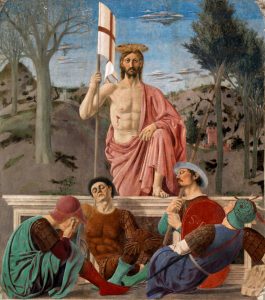Illuminations on the Lectionary readings for April 20, 2025 (Easter Sunday C – Principal Service)

The Resurrection of Jesus Christ (1463), mural in fresco and tempera by Piero della Francesca (1415-1492). Museo Civico di Sansepolcro, Arezzo, Tuscany, Italy. (Click image to enlarge.)
First Reading or alternate Second Reading: Acts 10:34-43
Alleluia. Christ is risen! The Lord is risen indeed. Alleluia! On Easter Sunday we celebrate the resurrection of Jesus Christ. The Lectionary readings for the principal Easter Sunday service consistently speak of resurrection and life. The first reading (which may optionally be used as second reading instead) is from the Acts of the Apostles, the evangelist Luke’s story about the life of the early church and its growth and spread. In this passage, we find Peter offering religious instruction in the household of the centurion Cornelius, a Roman army officer. Peter tells them about the Christian way: Jesus was crucified but raised from the dead, and now God’s saving grace is given through Jesus to Jew and Gentile, to all the nations. Jesus is Lord of all!
Alternate First Reading: Isaiah 65:17-25
In this alternate reading we turn to the closing chapters in Isaiah. The people have returned home to Jerusalem from their long exile in Babylon. Much work must be done to restore the war-battered city and the ruins of its first temple. But first, there is time for celebration. God promises through the prophet to make Jerusalem a virtual heaven on earth, where everyone will enjoy abundance and happiness, peace, and joy. Even the wolf and the lamb shall feed peacefully together!
Psalm: Psalm 118:1-2, 14-24
In this selection from Psalm 118, we repeat Israel’s joyful thanks to God for its return from exile. While the prophetic words, “The stone that the builders rejected has become the chief cornerstone,” alludes specifically to the temple in Jerusalem, Christians have long borrowed these words as a metaphor for Jesus. The verses shout out the hope of an Easter people: “I shall not die, but I shall live … The Lord … did not give me over to death. … you have answered me and have become my salvation.”
Second Reading: I Corinthians 15:19-26
Members of the early Christian community of Corinth were clearly puzzled by the idea of Jesus’s resurrection and probably arguing over its interpretation. In these verses, Paul tries simply and pastorally to express the resurrection and its significance: Recalling Adam’s fall and the ancient tradition of offering the first fruits of the harvest to God, Paul declares that Jesus’s resurrection makes Christ the first fruit of everlasting life, and this changes everything: The resurrection promises the arrival of God’s kingdom on earth and of eternal life. If Christ has risen, Paul says, then all who believe in him will also rise again.
Gospel: John 20:1-18
Each of the four Gospels tells of the resurrection from a different perspective, each reflecting the traditions of its particular community of origin. In John’s Gospel we walk this road with Mary Magdalene, portrayed in tender verses as the one who stayed behind at the empty tomb after the others had left. John portrays her as the first person to meet and speak with the risen Christ, and the one sent to proclaim the good news of his resurrection to the others. As in many other Gospel accounts of the risen Christ encountering his friends in unexpected ways, Mary did not recognize Jesus at first. But when he calls her name, we can feel the joy in her delighted response, “Rabbouni!”
Alternate Gospel: Luke 24:1-12
Eyewitness accounts of any great event typically differ on the details, and the Gospels’ resurrection narratives are no exception. Only in Luke’s Gospel do we hear that the women who came from Galilee with Jesus were the first to learn that Jesus was risen. Luke even called out three of them by name: Mary Magdalene, Joanna, and Mary the mother of James. But when these women hurried back to tell the grieving men this wonderful news, the men thought it was just “an idle tale.” Before he would believe the news, Peter ran to the empty tomb to see it for himself.
